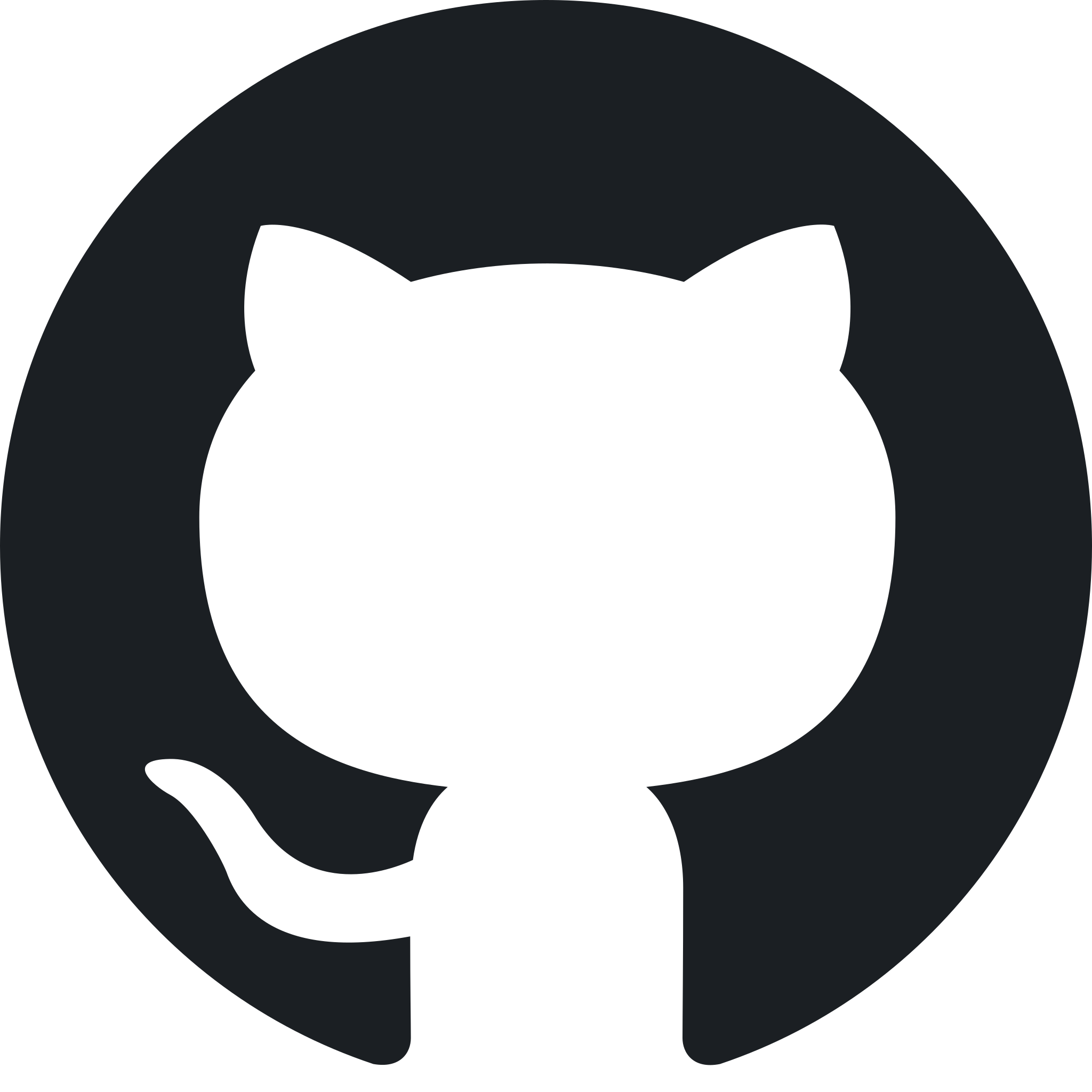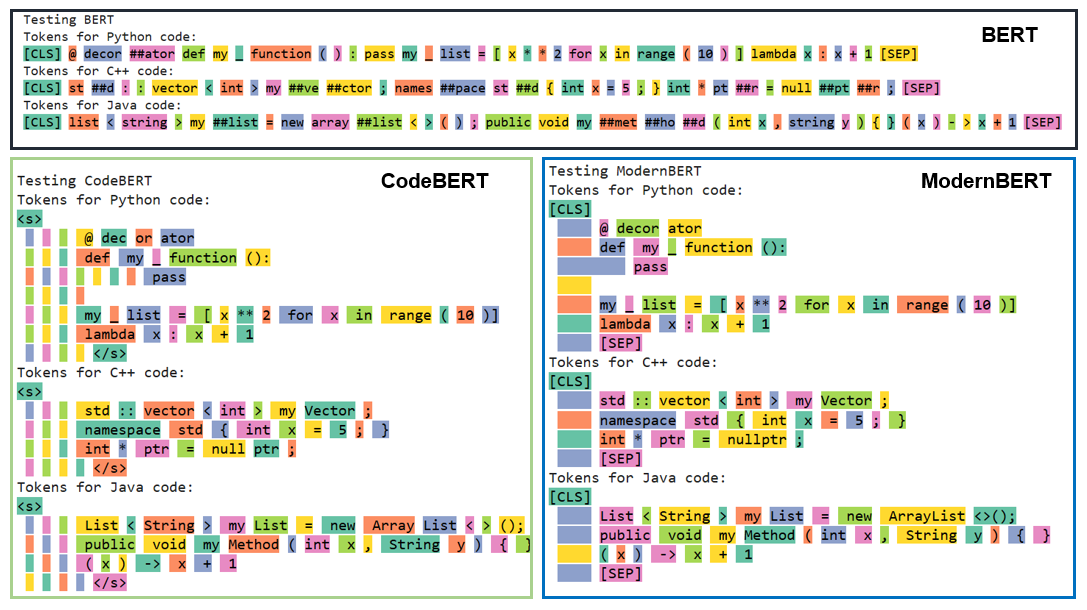Introduction
ModernBERT(2024) is the latest encoder-only model at the time of this blog's creation. The authors present it as a Smarter, Better, Faster, and Longer version of BERT, designed to improve performance across various NLP tasks.
One of the key claims in the paper is that ModernBERT's tokenizer—built using an advanced BPE-based tokenization method—is inherently "code-aware." This claim stems from the fact that it was trained on a diverse mix of code and natural language data.
The objective of this analysis is to rigorously evaluate ModernBERT's tokenizer in the context of code tokenization and compare its performance to that of BERT(2018) and CodeBERT(2020). Through various tests, this study aims to provide quantifiable insights into ModernBERT’s ability to handle programming constructs. Ultimately, this should help developers and researchers decide whether ModernBERT is the right choice for their applications, such as retrieval-augmented generation (RAG) and other code-related tasks.
Before diving into the evaluations, it is true that BERT is an older model, but it remains widely used. While BERT was not trained on code and has a vocabulary size of 30K, I include it here as a baseline for comparison.
On the other hand, CodeBERT was trained on a large code corpus and has a vocabulary size similar to ModernBERT (50K). See Figure 1
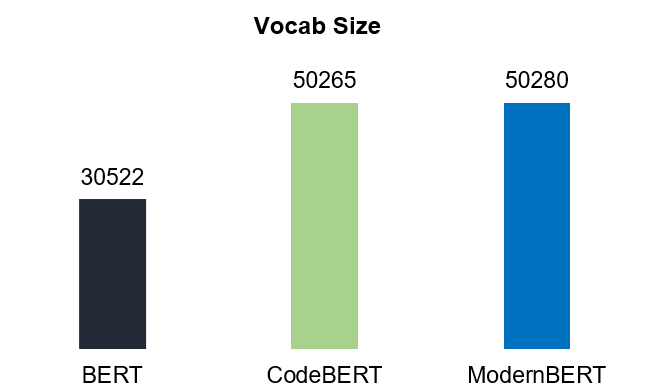
Whitespace & Tabs
Whitespaces
Whitespaces play a critical role in code formatting and readability. The goal of this study is to determine whether a tokenizer (BERT, CodeBERT, and ModernBERT) represents different-length whitespace sequences as a single token or splits them into multiple tokens.
For example, does a sequence of two spaces (" ") get tokenized as a single token, or does the tokenizer split it into two separate tokens? The same question applies to longer sequences of length L. See Figure 2
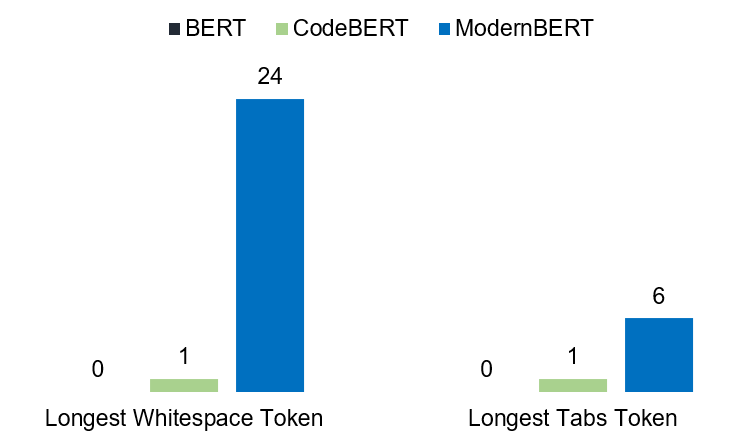
As expected, BERT does not have a dedicated token for whitespace (" ") This is because BERT uses the prefix "##" to indicate that a token is a continuation of the previous token. This mechanism allows BERT to implicitly track spaces between words without explicitly encoding whitespace tokens.
For example, the word "introduction" might be tokenized as: ['introdu', '##tion']. This means that the token "##tion" is connected to the previous token ("introdu") without an explicit space before it.
CodeBERT, on the other hand, has a single token for a single whitespace. This means that two spaces (" ") are split into two separate tokens. As a result, this tokenizer can be considered less code-aware in comparison to ModernBERT, especially when handling multiple consecutive whitespaces in code.
ModernBERT, however, takes a more efficient approach. maps sequences of up to 24 consecutive whitespaces to a single token. This allows it to handle longer whitespace sequences more efficiently. For example, a whitespace sequence of length 10 is tokenized into a single token. This is a significant advantage because ModernBERT reduces the number of tokens required for long sequences of spaces, unlike CodeBERT, which would require L tokens for a whitespace sequence of length L.
Indentation (Tabs)
When tokenizing a tab ("\t"), we get the following results:
| Tokenizer | Tokenized Result |
|---|---|
| BERT | [] |
| CodeBERT | ['ĉ'] |
| ModernBERT | ['ĉ'] |
As observed, BERT completely ignores tabs, just like it does with whitespaces. In contrast, both CodeBERT and ModernBERT map the tab ("\t") to the same token 'ĉ', which is present in the vocabulary of both models. While it is unclear whether CodeBERT uses BPE for tokenization, the similarity to ModernBERT’s behavior suggests that it might, since ModernBERT uses BPE.
Figure 2 illustrates the tab sequences that are mapped to a single token by the three tokenizers. Notably, the CodeBERT tokenizer splits any tab sequence longer than 1 (e.g., a sequence of three tabs \t\t\t) into separate tokens. On the other hand, ModernBERT can handle up to 6 consecutive tabs as a single token.
This behavior makes ModernBERT highly efficient for code representation, especially in programming languages like Python, where indentation (tabs) plays a critical role in defining code structure.
Tab-Space Merge
When tokenizing a sequence of mixed tabs and whitespaces, we find that ModernBERT is the only tokenizer that merges a whitespace and a tab (in this exact order) into a single token. Here are the results of tokenizing the sequence "\t \t \t":
| Tokenizer | Tokenized Result |
|---|---|
| BERT | [] |
| CodeBERT | ['ĉ', 'Ġ', 'ĉ', 'Ġ', 'ĉ'] |
| ModernBERT | ['ĉ', 'Ġĉ', 'Ġĉ'] |
As seen in the table, BERT ignores the sequence entirely. CodeBERT, on the other hand, tokenizes each part of the sequence separately, treating each tab and space as distinct tokens. ModernBERT, however, merges a tab and space (in this exact order) into a single token, resulting in a more compact representation.
This behavior further demonstrates ModernBERT’s capability to better handle code sequences, providing more efficient tokenization when dealing with tab-space combinations, which are common in programming.
Keywords & Operators
In this section, we analyze how the three tokenizers handle keywords and operators in three programming languages: Python, Java and C++
Keywords are reserved words in a programming language that have a predefined meaning and cannot be used as identifiers (e.g., variable names or function names). These are fundamental parts of the syntax in any language.
Operators are symbols used to perform operations on variables and values. For example, arithmetic operators like +, -, *, and / perform mathematical operations.
Keywords (Python, Java, C++)
To have the most accurate sets of keywords for the three languages:
- Python: We will use the built-in list of Python keywords.
- Java: The official list (50 elements of Java SE8+): Java Doc
- C++ (C++11 only): C++ Doc
| Programming Language | Tested Keywords |
|---|---|
| Python | 35 |
| Java | 50 |
| C++ | 85 |
N.B The keywords and operators data are available in pickle files in this repo . Feel free to use them.
The measured KPI here is the share of keywords that are tokenized as a single token (i.e., not split).
Figure 3 shows this KPI for the three tokenizers on the keywords of Python, Java, and C++.
An interesting insight here is that BERT, which was not trained on code, performs very well on the Python and Java sets. In fact, it performs better than ModernBERT on the Java set. However, this doesn't reveal much about the code abilities of BERT. This is because many keywords in Python and Java are common English words (e.g., else, true, false, try). This assumption is further supported by the fact that BERT struggles with C++ keywords, which tend to be more complex.
CodeBERT shows a medium but stable performance. Its results can be explained by the fact that it was trained on six different programming languages, which may have led to some loss of tokenization efficiency in favor of better generalization.
ModernBERT, on the other hand, consistently shows that it is well-aligned with programming languages.
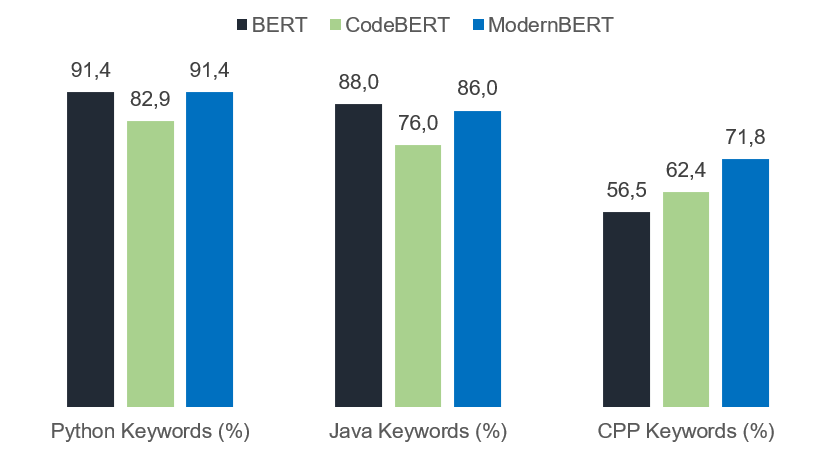
To dig a bit deeper, let's tokenize the 'elif' keyword, which is very Python-specific. We get the following results:
| Tokenizer | Tokenized 'elif' |
|---|---|
| BERT | ['eli', '##f'] |
| CodeBERT | ['el', 'if'] |
| ModernBERT | ['elif'] |
This proves that BERT still struggles with keywords that are not common English words. CodeBERT splits it into two tokens, while ModernBERT keeps it intact.
Operators
Why Operators Matter
Operators are fundamental to how code functions, and how well they are tokenized impacts the efficiency and effectiveness of any model working with code. Tokenizing operators properly is crucial for:
- Maintaining the integrity of the code.
- Ensuring correct representation of syntax for downstream tasks like code completion, code summarization, or error detection.
- Improving efficiency in tokenization—if operators are tokenized as single tokens, it could reduce the overall number of tokens needed to represent a piece of code.
For operators, we will use the following documentation pages:
| Programming Language | Tested Operators |
|---|---|
| Python | 34 |
| Java | 32 |
| C++ | 36 |

Unlike keywords, operators present a real challenge for BERT. Since it was not trained on a large code corpus, it struggles significantly with operators. CodeBERT and ModernBERT have decent performances, but ModernBERT's tokenizer seems to be the best in handling operators.
Test Data for Reproduction
Finally, here is the dataset containing all the test results. Feel free to reproduce the experiments, but don't forget to cite this blog/repository.
| Tokenizer | Vocab Size | Longest Whitespace Token | Longest Tabs Token | Tab-Space Merging | Python Keywords (%) | Java Keywords (%) | C++ Keywords (%) | Python Operators (%) | Java Operators (%) | C++ Operators (%) |
|---|---|---|---|---|---|---|---|---|---|---|
| BERT | 30,522 | 0 | 0 | ❌ | 91.4 | 88.0 | 56.5 | 50.0 | 43.8 | 38.9 |
| CodeBERT | 50,265 | 1 | 1 | ❌ | 82.9 | 76.0 | 62.4 | 67.6 | 75.0 | 66.7 |
| ModernBERT | 50,280 | 24 | 6 | ✅ | 91.4 | 86.0 | 71.8 | 82.4 | 90.6 | 86.1 |
